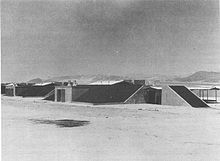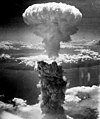Projet Camel


Le projet Camel est le nom de code donné au projet de recherche effectué par le California Institute of Technology (Caltech) à l'appui du Projet Manhattan pendant la Seconde Guerre mondiale. Ces activités comprennent l'élaboration de détonateurs et d’autres équipements, des tests sur la bombe lancée depuis des bombardiers Boeing B-29 Superfortress, et le Salt Wells Pilot Plant, où les composants explosifs des armes nucléaires ont été fabriqués.
Notes et références
[modifier | modifier le code]- (en) Cet article est partiellement ou en totalité issu de l’article de Wikipédia en anglais intitulé « Project Camel » (voir la liste des auteurs).
Bibliographie
[modifier | modifier le code]- (en) Elizabeth Babcock, Magnificent Mavericks : Transition of the Naval Ordnance Test Station from Rocket Station to Research, Development, Test, and Evaluation Center, 1948–58, Washington, DC, Naval Historical Center and the Naval Air Systems Command, , 618 p. (ISBN 978-0-945274-56-8, OCLC 186348197, lire en ligne)
- (en) Richard H. Campbell, The Silverplate Bombers : A History and Registry of the Enola Gay and Other B-29s Configured to Carry Atomic Bombs, Jefferson, North Carolina, McFarland & Company, , 235 p. (ISBN 0-7864-2139-8, OCLC 58554961)
- (en) J. D. Gerrard-Gough et Albert B. Christman, The Grand Experiment at Inyokern, Washington, D.C., U.S. Government Printing Office, (OCLC 251693280)
- (en) Richard G. Hewlett et Oscar E. Anderson, The New World, 1939–1946, University Park, Pennsylvania State University Press, , 766 p. (ISBN 0-520-07186-7, OCLC 637004643, lire en ligne)
- (en) Richard G. Hewlett et Francis Duncan, Atomic Shield, 1947–1952, University Park, Pennsylvania State University Press, (ISBN 0-520-07187-5, OCLC 3717478)
- (en) Lillian Hoddeson, Paul W. Henriksen, Roger A. Meade et Catherine L. Westfall, Critical Assembly : A Technical History of Los Alamos During the Oppenheimer Years, 1943–1945, New York, Cambridge University Press, , 509 p. (ISBN 0-521-44132-3, OCLC 26764320)
